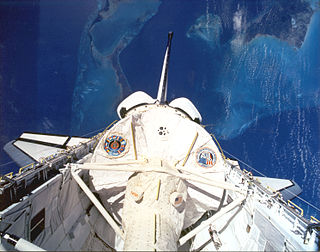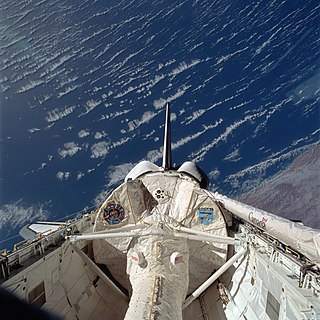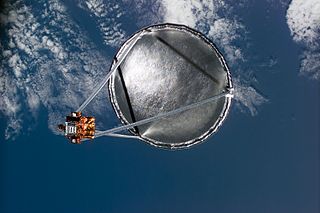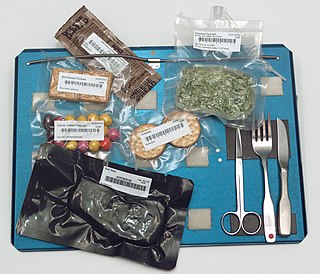
STS-50 was a NASA Space Shuttle mission, the 12th mission of the Columbia orbiter. Columbia landed at Kennedy Space Center for the first time ever due to bad weather at Edwards Air Force Base caused by the remnants of Hurricane Darby.

STS-47 was NASA's 50th Space Shuttle mission of the program, as well as the second mission of the Space Shuttle Endeavour. The mission mainly involved conducting experiments in life and material sciences inside Spacelab-J, a collaborative laboratory inside the shuttle's payload bay sponsored by NASA and the National Space Development Agency of Japan (NASDA). This mission carried Mamoru Mohri, the first Japanese astronaut aboard the shuttle, Mae Jemison, the first African-American woman to go to space, and the only married couple to fly together on the shuttle, Mark C. Lee and Jan Davis, which had been against NASA policy prior to this mission.

STS-77 was the 77th Space Shuttle mission and the 11th mission of the Space Shuttle Endeavour. The mission began from launch pad 39B from Kennedy Space Center, Florida on 19 May 1996 lasting 10 days and 40 minutes and completing 161 revolutions before landing on runway 33. The defense and aerospace technology company L'Garde was responsible for the design and manufacture of the Antenna in the Inflatable Antenna Experiment, a key component of the STS-77 mission.

STS-83 was a NASA Space Shuttle mission flown by Columbia. It was a science research mission that achieved orbit successfully, but the planned duration was a failure due to a technical problem with a fuel cell that resulted in the abort of the 15 day duration. Columbia returned to Earth just shy of four days. The mission was re-flown as STS-94 with the same crew later that year.

STS-87 was a Space Shuttle mission launched from Launch Complex 39B of the Kennedy Space Center on 19 November 1997. It was the 88th flight of the Space Shuttle and the 24th flight of Columbia. The mission goals were to conduct experiments using the United States Microgravity Payload (USMP-4), conduct two EVAs, and deploy the SPARTAN-201 experiment. This mission marked the first time an EVA was performed from Columbia. EVAs from Columbia were originally planned for STS-5 in 1982 and STS-80 in 1996, but were canceled due to spacesuit and airlock problems, respectively. It also marked the first EVA conducted by a Japanese astronaut, Takao Doi.

Bonnie Jeanne Dunbar is an American engineer and retired NASA astronaut. She flew on five Space Shuttle missions between 1985 and 1998, including two dockings with the Mir space station.

Michael Landon Gernhardt is a NASA astronaut and manager of the Environmental Physiology Laboratory, and principal investigator of the Prebreathe Reduction Program (PRP) at the Lyndon B. Johnson Space Center.

The Fluid Science Laboratory is a European (ESA's) science payload designed for use in Columbus built by Alenia Spazio, OHB-System and Verhaert Design and Development. It is a multi-user facility for conducting fluid physics research in microgravity conditions. It can be operated in fully or in semi-automatic mode and can be controlled on board by the ISS astronauts, or from the ground in the so-called telescience mode.

Space manufacturing or In-space manufacturing is the fabrication, assembly or integration of tangible goods beyond Earth's atmosphere, involving the transformation of raw or recycled materials into components, products, or infrastructure in space, where the manufacturing process is executed either by humans or automated systems by taking advantage of the unique characteristics of space. Synonyms of Space/In-space manufacturing are In-orbit manufacturing, Off-Earth manufacturing, Space-based manufacturing, Orbital manufacturing, In-situ manufacturing, In-space fabrication, In-space production, etc.

Major Paolo Angelo Nespoli is an Italian astronaut and engineer of the European Space Agency (ESA). In 2007, he first traveled into space aboard the Space Shuttle Discovery as a mission specialist of STS-120. In December 2010 he again traveled into space aboard the Soyuz TMA-20 spacecraft as an Expedition 26/27 flight engineer. Nespoli's third spaceflight was on board Soyuz MS-05, which launched in July 2017 for Expedition 52/53. He was also the European Space Agency's oldest active astronaut prior to his retirement in 2019.

Space food is a type of food product created and processed for consumption by astronauts during missions to outer space. Such food has specific requirements to provide a balanced diet and adequate nutrition for individuals working in space while being easy and safe to store, prepare and consume in the machinery-filled weightless environments of crewed spacecraft. Space food is commonly freeze-dried to minimize weight and ensure long shelf life.

The International Space Station is a platform for scientific research that requires one or more of the unusual conditions present in low Earth orbit. The primary fields of research include human research, space medicine, life sciences, physical sciences, astronomy and meteorology. The 2005 NASA Authorization Act designated the American segment of the International Space Station as a national laboratory with the goal of increasing the use of the ISS by other federal agencies and the private sector.

Lunar IceCube is a NASA nanosatellite orbiter mission that was intended to prospect, locate, and estimate amount and composition of water ice deposits on the Moon for future exploitation. It was launched as a secondary payload mission on Artemis 1, the first flight of the Space Launch System (SLS), on 16 November 2022. As of February 2023 it is unknown whether NASA team has contact with satellite or not.

ISSpresso was the first espresso coffee machine designed for use in space, produced for the International Space Station by Argotec and Lavazza in a public-private partnership with the Italian Space Agency (ASI). ISSpresso was one of nine experiments selected by the Italian Space Agency for the Futura mission. It was installed on the space station between 2015 and 2017, when it was returned to Earth.

Expedition 52 was the 52nd expedition to the International Space Station. It officially began on June 2, 2017 10:47 UTC, with the undocking of Soyuz MS-03. Transfer of command from Expedition 51 was done on June 1, 2017.
Advanced Research Thermal Passive Exchange (ARTE) is a project intended to create "Thermal Exchange", an experiment for the International Space Station (ISS). It is a heat pipe technology demonstrator in which the heat pipes contain low toxicity fluid. Thermal Exchange has been designed by Argotec in collaboration the Italian Space Agency (ASI). Polytechnic University of Turin participated in the project with the development of a prototype of the electronics and software. On April 4, 2016, the experiment was conducted nominally on board the International Space Station by the American astronaut Timothy Kopra.

Expedition 53 was the 53rd expedition to the International Space Station, which began upon the departure of Soyuz MS-04 on September 2, 2017, and concluded upon the departure of Soyuz MS-05 on December 14, 2017. Randolph Bresnik, Paolo Nespoli and Sergey Ryazansky were transferred from Expedition 52, with Randolph Bresnik taking the commander role. Transfer of Command from Expedition 53 to Expedition 54 was done on December 13, 2017. Expedition 53 officially ended on December 14, 2017 5:14 UTC, with the undocking of Soyuz MS-05.

ArgoMoon is a CubeSat that was launched into a heliocentric orbit on Artemis 1, the maiden flight of the Space Launch System, on 16 November 2022 at 06:47:44 UTC. The objective of the ArgoMoon spacecraft is to take detailed images of the Interim Cryogenic Propulsion Stage following Orion separation, an operation that will demonstrate the ability of a cubesat to conduct precise proximity maneuvers in deep space. ASI has not confirmed nor denied whether this took place, but several images of the Earth and the Moon were taken.
The Human Space Flight Centre (HSFC) is a body under the Indian Space Research Organisation (ISRO) to coordinate the Indian Human Spaceflight Programme. The agency will be responsible for implementation of the Gaganyaan project. The first crewed flight is planned for 2024 on a home-grown LVM3 rocket.

SpaceX CRS-24, also known as SpX-24, was a Commercial Resupply Service mission to the International Space Station launched on 21 December 2021, at 10:07:08 UTC. The mission is contracted by NASA and is flown by SpaceX using a Cargo Dragon. This is the fourth flight for SpaceX under NASA's CRS Phase 2 contract awarded in January 2016.

















